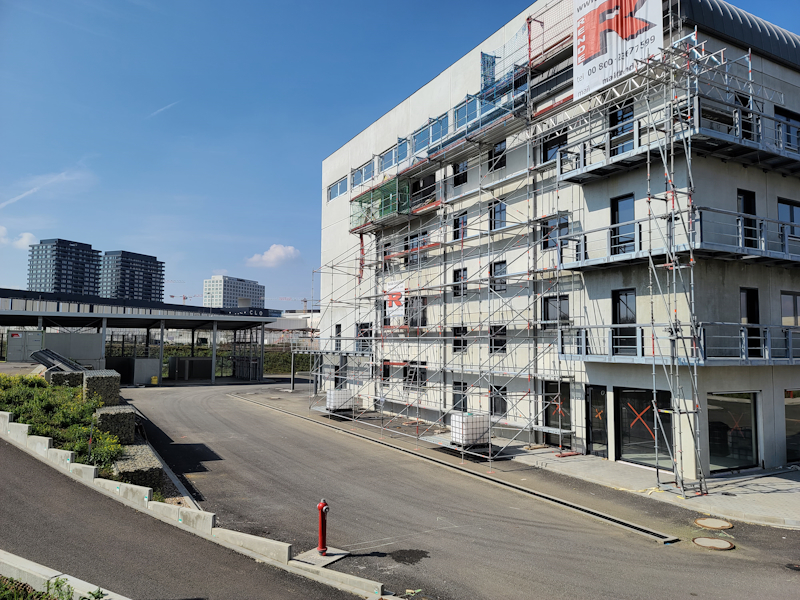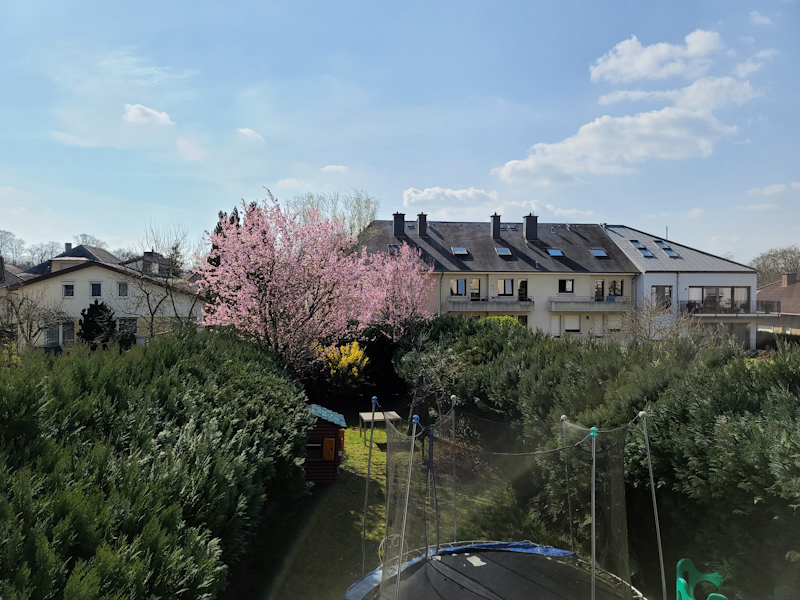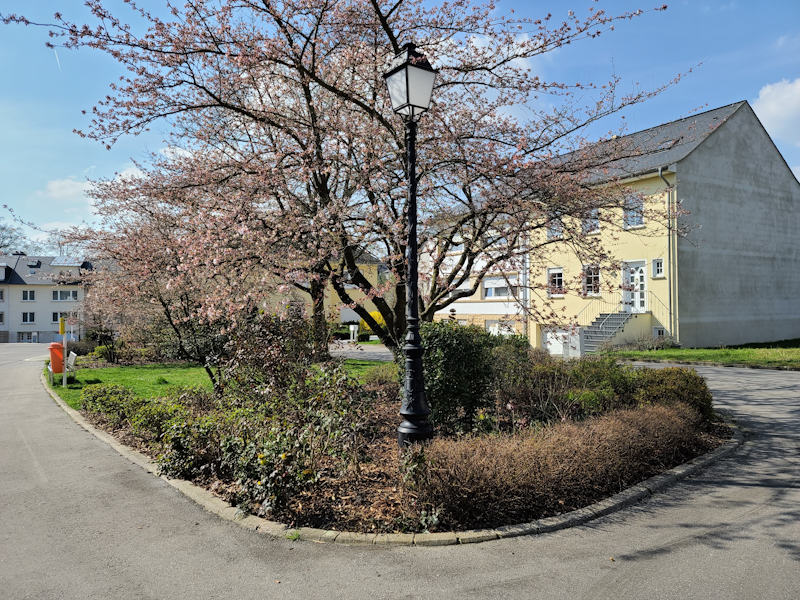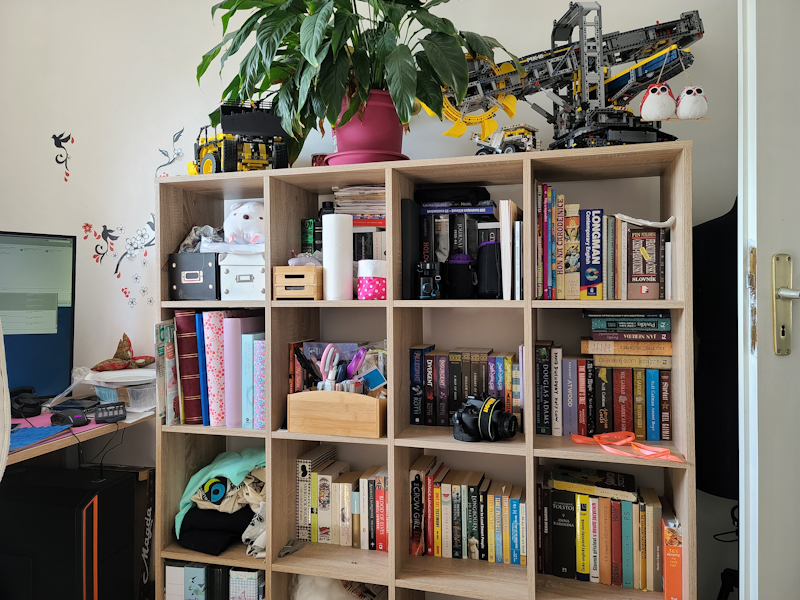The Samsung Galaxy S20+, S20 Ultra Exynos & Snapdragon Review: Megalomania Devices
by Andrei Frumusanu on April 3, 2020 9:30 AM ESTCamera: Daylight Evaluation Continued
I focused on the differences between the S20 devices until now, so let’s take a better look at how they compare against the competition and their predecessors.

[ Galaxy S20U - (S) ]
[ Galaxy S20U - (E) ]
[ Galaxy S20+ (E) ]
[ Galaxy S10+ (S) ] - [ Galaxy S10+ (E) ]
[ iPhone 11 Pro ] - [ Pixel 4 ]
[ Mate 30 Pro ] - [ P30 Pro ]
[ X-T30 ]
On the main camera units, things actually don’t differ all too much in terms of compositions between the different devices. I maybe would have wished for a bit brighter highlights as the phones are again still to shy on those last 10% of levels which didn’t quite convey the sun-lit façade of the building.
The high-light texture retention and sharpening comments made earlier again apply here to both the S20 Ultras. I prefer the Exynos shot as it’s more natural, but it’s a subjective preference choice.
The Ultra-Wide angle is really good in terms of exposure and dynamic range on the S20’s, however I do see the reduction in resolution compared to the S10 as the new phone actually does see a downgrade in the amount of captured details.
I don’t know what’s happening on the Exynos S20 Ultra unit’s Ultra-Wide, but there’s this blob of blurriness in the very center of the image on both phones. It’s as if the phone was trying to do some image fusion with another sensor but failing at it spectacularly. This isn’t present on the S20+.

[ Galaxy S20U - (S) ]
[ Galaxy S20U - (E) ]
[ Galaxy S20+ (E) ]
[ Galaxy S10+ (S) ] - [ Galaxy S10+ (E) ]
[ iPhone 11 Pro ] - [ Pixel 4 ]
[ Mate 30 Pro ] - [ P30 Pro ]
[ X-T30 ]
The S20’s main competition is the iPhone 11, and frankly here they’re losing out to Apple when it comes to the composition of the scene, as the 11 Pro is able to maintain much better dynamic range without clipping the blacks as badly as on the Galaxy phones. In terms of details I also prefer the iPhone as it’s producing a much more natural look. The Snapdragon S20 Ultra’s over-sharpening is again far too much and doesn’t look good, particularly on artificial objects and contours.
The Ultra-Wide here is also a straight down-grade from what we saw on the S10, with lower resolution and worse dynamic range.
Briefly looking at the super-high res images again, it’s as if the two S20 Ultras had completely different sensors as the Snapdragon unit is again far blurrier and feels lower resolution as to what the Exynos is able to achieve. However here it’s the S20+’s 64MP unit which shines as it’s able retain a lot more detail than either Ultra – check out the book shelves on the center-left side.

[ Galaxy S20U - (S) Auto ]
[ Galaxy S20U - (S) Tap ]
[ Galaxy S20U - (E) Auto ]
[ Galaxy S20U - (E) Tap ]
[ Galaxy S20+ (E) Auto ]
[ Galaxy S20+ (E) Tap ]
[ Galaxy S10+ (S) ] - [ Galaxy S10+ (E) ]
[ iPhone 11 Pro ] - [ Pixel 4 ]
[ Mate 30 Pro ] - [ P30 Pro ]
[ X-T30 ]
The S20 phones here had some problems for actually exposing for the foreground of the scene instead of the sky or the actual sun. The S10+E and Pixel 4 are actually amongst the best devices here, but still quite a bit far from the raw dynamic range of the scene (See X-T30 reference). There’s also some severe lens flaring here that wasn’t as prevalent is past devices – again likely due to the larger sensor sizes this year.

[ Galaxy S20U - (S) ] - [ Galaxy S20U - (E) ]
[ Galaxy S20+ (E) ]
[ Galaxy S10+ (S) ] - [ Galaxy S10+ (E) ]
[ iPhone 11 Pro ] - [ Pixel 4 ]
[ Mate 30 Pro ] - [ P30 Pro ] - [ X-T30 ]
Here’s also a scene where I think the new S20’s fail to compete with the iPhone 11 Pro in terms of either detail or dynamic range processing. It’s an upgrade over the S10 series, but I had expected more out of the camera hardware.
These samples also showcase some odd behavior between the Snapdragon and Exynos at 108MP resolution. The latter is just again massively sharper, showing more natural resolution. On the Snapdragon when you closer on the tree branches you see a ton of ghost images. I think what’s happening here is that the phones are taking multiple shots for the HDR compositing, but the Exynos is able to do this in a more optimized way. Also check out the left background buildings on the Snapdragon – it’s a ton sharper and seemingly more in focus, probably a sign that the two phones are focusing on totally different things.

[ Galaxy S20U - (S) ] - [ Galaxy S20U - (E) ]
[ Galaxy S20+ (E) ]
[ Galaxy S10+ (S) ] - [ Galaxy S10+ (E) ]
[ iPhone 11 Pro ] - [ Pixel 4 ]
[ Mate 30 Pro ] - [ P30 Pro ] - [ X-T30 ]
In an indoor shot, the S20 phones also fail to catch up with the iPhone 11. The new phones are certainly upgrades to the S10 series, but I think the dynamic range is a bit lacking and then there’s again the issue of sharpness – over-sharpening on the Snapdragon phone, and the general optics concerns all the models.
Overall Daylight Conclusion – Somewhat Disappointing
The S20 series feel like they’re overpromising and under-delivering on their camera capabilities when it comes to captures. Samsung delivered some incredible hardware here when it comes to the paper specifications, but I feel that it fell short of actually materializing in actual better camera captures.
Starting off with the S20 Ultra: The phone’s telephoto module does deliver on its promises, and the combination of a 4x optical magnification module with a 48MP sensor achieves some incredible zooming capabilities that are clearly far ahead of any other device on the market today. There’s not much more to say here – if you want a phone with an excellent telephoto module, then the S20 Ultra is the obvious choice.
The S20 Ultra’s 108MP main camera was quite unconvincing to me in the daylight shots. There are several layers that we have to peel apart here. First of all, there are very obvious processing differences between the Snapdragon and Exynos models this year. While on the S10 series this was in favor of the Snapdragon, I feel the other way around for the S20 series as the sharpening on the S20 Ultra here has gone absolutely haywire on all the camera’s modules, going beyond what one would consider an improvement of picture quality into the realm of actually being detrimental to the picture. The Exynos variant here seemingly has no sharpening processing at all, and it feels a ton more natural.
On the matter of the 108MP picture shots, there’s also very stark differences between the two variants of the phone, and the Exynos model somehow is consistently ahead in terms of the sharpness and natural resolutions of the shots. I don’t know what the cause for this is, but the two phones clearly are using very different mechanisms to get to the end results.
Lastly and most importantly, I feel like the optics of the modules aren’t able to keep up with the camera sensors. I feared this would happen because of the sensor’s humongous size, and it did show up in the images, and the edges of the picture just aren’t as sharp as on phones with smaller sensors, including the S20+.
The S20 Ultra’s massive quality hole in the 1.1x to 3.9x zoom range is just atrocious. Samsung here severely lags behind Huawei’s processing prowess in actually using the 108MP’s full resolution during the sensor fusion, and particularly shots in the 2x range just look really bad compared to the S20+ and other phones with 2x optical modules. The current software solution of stitching the telephoto module picture into the middle of a digitally magnified 12MP shot just feels like some intern’s implementation. Samsung has the hardware ability to address this, but let’s see on whether they’ll do this.
The Ultra-Wide module also feels like a downgrade compared to the S10 series. I’ve most used this module in daylight settings anyway and I loved the results on the S10 series, and the loss of resolution on the S20’s here is just a negative with essentially no added positives for the new module.
Finally, the S20+’s camera system, at least in daylight, seems like a much more sensible configuration. It doesn’t suffer as badly from the optics on the main sensor, and Samsung’s implementation of the 64MP sensor as a secondary wide-angle resolves the problems of having mediocre intermediary zoom levels. Sure, it doesn’t zoom quite as far and clear as the S20 Ultra, but it’s in line with current 2x optical modules and even slightly outperforms them beyond that, resulting in useable 3-4x shots with plenty of clarity. Ironically enough, I also find that the 64MP shots on the S20+ more often than not actually beats the 108MP shots of the S20 Ultra due to the better optics – although these are not perfect as there’s evident hazing in very high contrast objects.
Frankly, I’m quite disappointed in the results of the S20 series. They’re still good, and represent upgrades to the S10 series in most scenarios, but they fall short of the overhyped expectations. I think Apple’s iPhone 11 Pro’s main sensor quality and pictures are still a step above what the S20’s can deliver in daylight, with cleaner, sharper and more natural results. Huawei also is seemingly years ahead of Samsung when it comes to complex camera systems like the one employed on the S20 Ultra, having much better optics and the proper software processing to actually deal with the multiple modules.










137 Comments
View All Comments
crimson117 - Friday, April 3, 2020 - link
$1400 is absurd. There's no way they're worth more than twice as much as a brand new S10.Andrei Frumusanu - Friday, April 3, 2020 - link
Probably one of the reasons Samsung still continues to sell the S10 series. They're really excellent value right now, and you're not missing out on too much.cha0z_ - Monday, April 6, 2020 - link
You are literally getting just one more year of software support going for s10 series... samsung software support policy is abysmal with less than two years of real support and from there just security. I got both iphone 11 pro max and exynos note 9, if I put aside the cr*ppy 9810 - it will not receive even the oneUI 2.1 as an update, while samsung will soon release it for s10 line. Enough said, note 9 is year and a half old.How can you recommend someone 1000 euro or 1400 euro phone if it will be supported for 1.5 years and from there 1.5 more security updates next to apple with 5 years FULL support with major, minor, day one, betas + security update for old iphones like 4s and 5 (2011 and 2012 respectably)?
goatfajitas - Monday, April 6, 2020 - link
You do realize the phone doesn't stop working when it doesn't get an OS update right? TBH, neither Android or IOS has added a whole lot in the past few years, its just a yearly cadence of very minor updates and not getting them means almost zero in actual use.Featherinmycap - Monday, April 6, 2020 - link
I think there have been a lot of added features to IOS in the last 3 years that I use a great deal. Not saying that Android didnt already have some of these features, but for IOS users we got with IOS 11; a file manager (finally), Messages sync with iCloud, screen recording, useful improvements to Siri and ApplePay. IOS12; lots of performance improvements (lots), Screentime, Shortcuts (scripting), CarPlay, Animoji Memoji, Tracking prevention, IOS13; Single Sign on, external storage, Dark Mode, better support for keyboards, trackpads/mice, etc.Famorcan007 - Tuesday, April 7, 2020 - link
I think it's because Android mostly has offered those features(file manager,screen recording, external storage,support for mice etc.) since way back compared to iOS' slow but steady trickle of features that's why iOS users feel every OS update is huge and significant. I'm using a Note 4(my backup device) right now to comment which doesn't feel too crippled compared to my Android 9 P20 pro.cha0z_ - Tuesday, April 7, 2020 - link
Let's not find an excuse - software support is software support. Security is security - some of us keep all their personal info on their device (most of us) + bank accounts and whatnot, risking compromise on your phone is not that innocent compared to what was like back in the days. IOS adds rapidly more features for sure compared to android that recently starts to look more and more like IOS (and I personally totally don't like that), but still added some good stuff under the hood and some new features.It's not serious to sell 1400 euro phone that is supported for one year and a half. I own exynos note 9 - it's 1.5 years old and already samsung dropped the support, s10 line received oneUI 2.1, note 9 will not. How is that for my 1000 euro phone + double served with that cr*ppy exynos 9810 in it. Now it's in my GF and I am rolling iphone 11 pro max. I prefer android and love oneUI, but I am tired to be a second hand customer.
s.yu - Tuesday, April 7, 2020 - link
Don't know what you're talking about. My Note8 just got another update days ago, one that I preferred not to have because each update comes with a risk of bricking the device while potential changes to the UI are not always welcome either. I also got it ~30% off retail a few months after release, such has always been the state of Samsung, at least for S and Note.I'm no longer buying Samsung but the main reason is lack of the 3.5mm port, if I have to name another then it's between the questionable choice of telephoto in the smaller variants or the oversized device with a mediocre battery(I regard 5000mah to be mediocre for the size). I still do like the UI but I'm willing to look around.
Psyside - Tuesday, April 7, 2020 - link
"It's not serious to sell 1400 euro phone that is supported for one year and a half. I own exynos note 9 - it's 1.5 years old and already samsung dropped the support, s10 line received oneUI 2.1, note 9 will not. How is that for my 1000 euro phone"Very easy, with those "very old software features" Samsung can do what MAC can't, and don't get me start it on the utter crap IOS.
Also don't spin it, Samsung offer 4 (four) years of security updates, so do your research before you type something.
cha0z_ - Wednesday, April 8, 2020 - link
fanboy. Security update hahahahah iphone 4s and 5 still receives security updates - 9 years old phone for 4s. What you will say now?iphone receive FULL support with MAJOR ios versions, updates, minor updates, BETA versions, DAY ONE as their newest and most expensive phone - for 5-6 years and you are talking about 4 years of security updates roflmao. Samsung released note 9 with android 8 when android 9 was already released from more than a months. Oooo, it's enough time, because you can dev your skin and features on top of the dev previews, especially the later ones that are closer to final (for the more tricky/deeply integrated code) - so no excuse for what they did. Basically they gave me one major update - android 10 as android 9 should had been on the note 9 from the start. Even if we count 2, how is that next to 5-6 versions of ios?
And before you talk some more fanboy bs that never used recent years iphones - ios brings a lot more in every new versions (adding features that was missing for no reason, like external USB flash support, file browser for the files on the phone, etc) while android 10 brings you what? More lockdown ios style, iphones gestures and pixel device that is a cheap iphone wannabe.
Because of people like you samsung don't want to change their software support policy. Why should they? It costs money or now you will start with the argument how the phone hardware is not supporting oneUI 2.1 (for the note 9 that is 1.5 years old, but will not receive it most likely ;) ). Or maybe android 11 will be too much for the phone, right? :D
Also I agree - my note 9 can do more than my iphone 11 pro max, but everything that the phones do both (and that's 99.9% of what you will end up using constantly) - the iphone 11 pro max makes the exynos note 9 look like a total utter joke - faster, smoother with NOT A SINGLE frame drop no matter what you do, gaming is insanely good with surprise - NOT A SINGLE frame drop, battery life is x3 times better, apps have MORE features and runs super smooth and great, speakers destroys the note 9 one, camera too is times better, materials are a lot better too, faceid is super good and fast - feels like I don't have any security on - never failed or gave me any issue. Fun fact, note 9 came with fortnite and recommended as gaming phone for that game. My exynos variant can't run smoothly the game even with 30fps cap medium settings and !1080p! while iphone XS max runs it 60fps high 2688x1242 without a single frame drop. Same goes for the 11 pro max, obviously.
As for ios - it improves massively and adds more and more missing features/drops restrictions with every version. ios 14 is already known to drop more. I prefer android, because I can do more + I love oneUI, but that doesn't change the fact that in my country I will receive exynos and 1.5 years of decent support. And in the end of the day - I spend my time in apps, not in the settings menu and apps on ios are better, with more features, smoother, a lot of them exclusive to the platform. Can you play dead cells on your android device? No? Yeah, the port is expected around the end of the year, I have it from June 2019. Full blown civilization 6 on your android device? Yeah, will never come, I have it and it's 1:1 port that runs great. Can go on and on and on. If you spend your time tweaking settings, options, UI - good for you, I spend my time in games and apps.